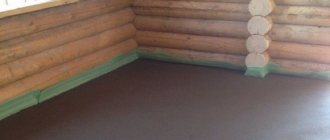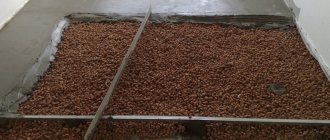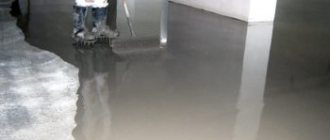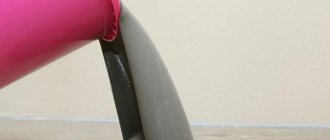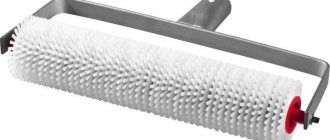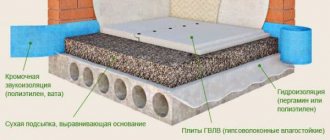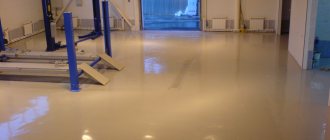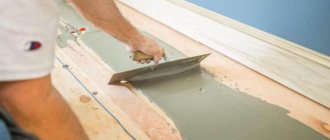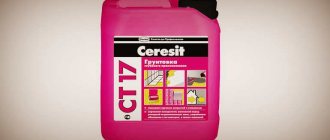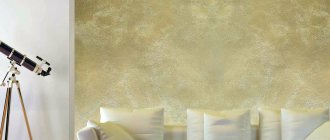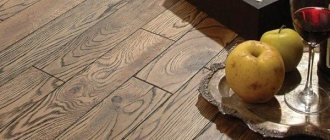Rarely does anyone pay attention to gender. It's smooth and that's the main thing. Most often, tiles of soft colors with an unobtrusive pattern are used for floors. But the future belongs to epoxy self-leveling floors. These bright coatings immediately attract attention, you can look at them for a long time, and most importantly, the surface of the floors is very smooth, despite the catchy, seemingly voluminous pattern. Initially, epoxy flooring was only available in industrial premises such as shopping centers, shops, and hotels. But since the technology for creating such a coating is improving every year, self-leveling floors have become available even in the smallest apartments. And manufacturers produce special mixtures that will help you create a bright and smooth surface yourself, without turning to specialists.
What is epoxy self-leveling floor
The main component of the self-leveling coating is a transparent epoxy resin for filling the floor, to which special hardeners, plasticizers and solvents are mixed. Also, various colorful bright decorative particles of various shades and other components can be added to these mixtures, designed to improve the quality of the self-leveling epoxy floor.
In addition, glitter and so-called chips are added to the mixture for self-leveling flooring. Glitters are shiny and iridescent particles similar to mother-of-pearl. Chips are reflective particles presented in the form of fibers. Depending on what decorative particles are added to the mixture for epoxy floors, there are 4 types of finished coatings:
- matte;
- glossy;
- semi-matte;
- semi-gloss.
Brief description, features and benefits
Epoxy floors are a type of polymer coating based on resin, a special hardener and stabilizers. They are used to create bases with high strength, wear-resistant and decorative characteristics.
The epoxy floor is applied “in bulk” - this allows the mixture to flow freely over the plane, creating an absolutely flat and seamless surface. To improve the decorative properties of the floor, the installation involves mixing and joining different color schemes, applying color streaks and strokes, adding various glosses, etc.
In addition to mixing shades, various decorative elements can be used - chips, flocks and glitters. These elements are matte, semi-matte or shiny particles that are applied to the finishing layer and sealed with a transparent composition.
A distinctive feature of this coating, in addition to durability, is its high decorative effect and a wide selection of colors.
The scope of application of such floors is extensive and not limited to specific tasks. These include the energy and food industries, chemical industries, parking complexes and car service centers, medical and household institutions, shopping and exhibition complexes.
For installation in apartments and country houses, the technology of self-leveling epoxy floors suggests the use of mixtures of a similar composition, as for installation in places with a more aggressive attitude towards the floor surface.
The standard liquid solution for such a floor is a two-component composition containing an epoxy-colored base and a hardener. The solution is supplied and distributed in different containers. The mixture is prepared only before pouring onto a leveled and prepared base.
Types of self-leveling coatings
Epoxy resin floors are divided into two main types:
- Thin layer self-leveling epoxy floor. This coating is distinguished by the fact that the thickness of its filling is less than 1 mm. Characteristics: excellent moisture resistance, the floor can withstand the effects of aggressive chemical cleaners containing abrasive substances. Unfortunately, such floors cannot have a beautiful appearance.
- The second type of epoxy resin coatings includes floors with a pour thickness of more than 1 mm. In addition to all the advantages inherent in thin-layer floors, these coatings are also resistant to acids and alkalis, they are ultra-strong and durable, and also have an attractive and bright appearance.
In addition to these two main groups, there are three more types of self-leveling coatings:
- Epoxy industrial floors. Filling no more than 6 mm, they are able to withstand enormous loads, very heavy furniture and many people constantly moving on such a coating.
- Quartz-filled self-leveling floors. The thickness of pouring such a floor covering is from 1 mm to 6 mm. Thanks to the content of quartz sand, floors become highly resistant to mechanical stress, as well as to the action of chemical detergents containing abrasive particles. In addition, the floor is resistant to temperature changes.
- Self-leveling epoxy floor with increased transparency. The thickness of the filling layer of such a coating is 2 mm. But to create a beautiful decorative layer, you can fill it with a height of up to 5 mm. After complete drying, the epoxy resin for flooring forms a thin transparent film with increased light resistance; the coating is completely antistatic. This mixture is mainly used for filling photographs, 3D drawings and floor patterns.
How to calculate quantity
How to produce epoxy resin flooring calculator for 1 square meter? On average (depending on the composition of the mixture) per square meter. m. you need to pour 1 liter of solution with a layer thickness of one millimeter.
For industrial epoxy floors, mixtures can be used that contain substances that increase its weight. Then the consumption will be 1.5-2 liters per 1 sq. m. When purchasing, it is worth checking the density of the composition.
For industrial epoxy floors, mixtures can be used that contain substances that increase its weight.
In what rooms can epoxy flooring be poured?
Flooring in the form of epoxy flooring can be used both in industrial premises and in apartments and private houses in the country.
Interesting to know! The self-leveling coating is always cool to the touch, so before installing it in residential areas, you should install electric floor heating.
Such a floor should be abandoned if water pipes will pass under it. If one of them bursts, you will have to open the entire coating, and this is a labor-intensive and very expensive task. As a result, you will have to re-fill the floors. Because epoxy flooring is non-slip, it is very convenient in shopping malls. And modern panoramic 3D drawings will add unusualness and attractiveness to the room.
Polymer properties
One of the most valuable features of epoxy resins is its independence from external factors. How is epoxy most often used in everyday life?
- For gluing homogeneous and dissimilar surfaces, the material and its texture often do not matter.
- For pouring large areas such as countertops and floors.
This does not require any extreme values of temperature and humidity, light brightness or its complete absence.
You only need to know the subtleties of the processes that occur during the polymerization of this resin, and it occurs only after mixing two components: the epoxy base itself and the hardener added to it, which starts the polymerization reaction.
To start, you only need to add the hardener in a strictly measured amount, recommended specifically for the purchased type of epoxy, and mix these two components very thoroughly.
If you are careless when mixing, then individual areas of the pour may differ greatly in quality from others. There will be more or less hardener in them than normal, and this will cause either poor hardening of individual areas, or general stickiness of the floor, which will be very difficult, if not impossible, to get rid of.
The normal curing temperature range can vary from 10°C to 200°C degrees. Such a big difference is due to the use of different types of resins: cold and hot curing. For household use, in the vast majority of cases, cold-curing epoxy is used.
Useful to know > How to properly dilute epoxy glue, what proportions should be observed
Yes, it has a sparse network of molecules after the hardening process is completed, and this implies less mechanical strength than a resin that is poured using the hot principle. But the fact is that in indoor or even workshop conditions, when it is necessary to make an epoxy-coated floor, it is not possible to use the hot process: raising the temperature in the room to 200°C degrees is already a fire hazard or even an explosive situation. Therefore, a cold safe method is used.
Advantages and disadvantages
Like any building material, epoxy resin flooring has its pros and cons. Thanks to them, you can decide whether it is worth installing such a coating. The advantages include:
- coating strength;
- no seams;
- resistance to chemicals;
- fire safety – epoxy flooring is not subject to fire;
- ease of maintenance of the coating;
- wear resistance - the floor can be used for at least 20 years;
- absolutely harmless to people and pets;
- Huge selection of colors and designs.
The advantages of such a floor also include the fact that epoxy coating for concrete floors does not release any harmful substances into the environment. But there are also disadvantages to epoxy flooring. The disadvantages include:
- high price;
- difficulty in installing the coating; It is quite difficult to make an epoxy resin floor with your own hands;
- it is almost impossible to remove.
The disadvantages, of course, are noticeably fewer, but they are there. If it is necessary to remove the epoxy floor, then this action is impossible, but you can simply pour a new layer of the mixture onto the old surface, then the coating will be renewed.
Advantages
Self-leveling epoxy floors have many advantages. Seamless technology allows you to fill it yourself and not need to contact specialists. This way you can save a lot of money on your family budget.
The self-leveling surface turns out to be extremely smooth, and the complete absence of any seams ensures its special hygiene - dirt, moisture and pathogenic organisms do not penetrate into the floor. It is highly advisable to use this technology in laboratories and clinics.
The composition also has high repellent properties - the floor is very easy to clean, and no strong accumulations of dirt form on it. Various chemicals and other substances cannot cause any damage to the coating. This is why epoxy flooring is often found in pharmaceutical plants or warehouses.
When applying the composition, it is necessary to adjust the degree of roughness of the self-leveling floor and prevent its slipperiness. Epoxy flooring can last for more than 20 years and is particularly resistant to abrasion and exposure to sunlight.
How to install epoxy flooring yourself
To make a high-quality epoxy floor with your own hands, you must adhere to a certain order of work stages:
- Preparing the base for pouring.
- Creating the main floor layer.
- Making a decorative layer.
- Final floor covering.
Pouring the floor begins with preparing the base
The most important thing is that the base must be completely horizontal. If there is even a slight slope, there will be an overconsumption of expensive material. Therefore, during the preparation of the base for the self-leveling floor, it is leveled with special concrete screeds. In the process of preparing the base for pouring, the old coating is completely cleared, then the debris is carefully swept out and vacuumed so that not a speck remains.
Important! One of the mandatory conditions is that the humidity of the base for the epoxy floor in the apartment should not exceed 4%.
When preparing the base for the floor covering, priming is carried out. A special mixture of epoxy primer for concrete floors is mixed with a construction mixer until smooth. In order for all air bubbles to disappear from the surface of the finished solution, you need to wait 5-7 minutes. Since the ready-made soil solution is useful for only 40 minutes, you need to mix it in precisely the proportions that will allow you to keep it within this short period of time. The primer is poured onto the prepared base using a snake. Using a regular padding polyester roller, the solution is carefully distributed, achieving a glossy floor. It is possible that some areas will absorb too much primer. Then you should add more solution exactly to these places and distribute it with a roller again. Polymerization occurs within 24 hours. When the primer has hardened, you can eliminate visible defects and pour a second layer, which will also dry for a day.
Creating the main floor layer.
When creating a base layer, all primer defects are completely hidden. Therefore, the layer thickness can be approximately 1.5 mm. The primer layer is again poured onto the prepared floor. Then it is carefully distributed using a spatula. After 20-30 minutes, special quartz sand is poured onto the entire floor surface. After this, you need to leave the floor to dry for 20 hours. Then the remaining sand is swept away with a plastic brush of increased rigidity and vacuumed.
Making a decorative layer.
This layer is an epoxy floor coating; it is installed on a ready-made primed base. The mixture is diluted according to the instructions using a mixer and after 5 minutes you can distribute it on the floor. Level the floor using a spatula. Decorative elements are added at this stage. After the layer is laid, you need to wait another 20 hours for drying.
Final coating.
The final stage requires very careful execution. You need to be extremely careful to avoid defects that will ruin the floor covering. The finished mixture is also diluted using a mixer; it is ready to use in 5 minutes. Then it is poured into wide strips, leveling the surface with a squeegee. After this, you need to go over it with a ring roller, which removes air bubbles, leaving a perfectly smooth and even surface. The final layer hardens within a day, but you should not use the room for about another week.
Interesting! In addition to the fact that the epoxy self-leveling floor has a smooth and glossy surface, it can be additionally varnished. This action will bring additional safety when using the floor. After varnishing the flooring with polyurethane varnish, you must wait 4-5 days and then you can use the room.
Pros and cons of polymer floor coverings
There are two types of self-leveling floors: organic binder and polymer. On organic it is based on Portland cement and gypsum, on polymer it is made of acrylic and polyurethane. Despite the fact that they are all “liquid”, they have quite serious differences. So we need to clarify what specific type we are talking about. We'll take a closer look at acrylic, touching on polyurethane along the way. These are the advantages of polymer flooring.
Two-component epoxy floor coating just needs to be mixed and applied.
- Polymer self-leveling floor spreads much better, even expensive compounds with organic binder. Their minimum layer is 1 mm, on cement or gypsum binder - from 5 mm. And if you use polymer-based paints, the layer will be from 0.5 mm.
- They do not generate dust, even after the top layer is worn out, because there is nothing to generate dust. According to the technology, the concrete base is primed, and then a polymer composition is applied. So, the soil itself makes the concrete low-dust. This, by the way, is the cheapest and most effective way to remove dust from concrete.
Epoxy self-leveling floor - the most hygienic coating - And the polymer coating wears out much less than even high-quality concrete coatings. The leader here is polyurethane - it is almost indestructible. But even good quality epoxy resin, especially with mineral fillers, wears off very little. Less than M500 concrete.
- Polymer self-leveling floors (PNP) do not peel off. Or rather, you need to greatly violate the technology (not use a primer or the wrong composition, apply it to wet concrete) for this to happen.
- Due to elasticity they absorb shocks. Chips and dents appear rarely, from very serious loads.
Epoxy coating is durable, beautiful, hygienic - Polymers - epoxy resin and polyurethane - do not allow moisture to pass through. Some species also do not carry out steam. This seems good, but if it is guaranteed not to get wet from below. That is, in order not to flood the neighbors below, this is an excellent choice. But laying it on the ground can be dangerous. If the waterproofing on the lower layers leaks, the water, unable to find a way out, will undermine the coating.
The disadvantages of polymer self-leveling floors are serious, but there are not so many of them. The main one is the price. They cost 10 times more than good brands of self-leveling floors based on cement or gypsum. But their consumption can be several times less - they begin to level out from a few millimeters. However, in order for the layer to be small, the base must be perfectly flat. And this is not easy. And one more point: it is better to pour polymers onto a base with a cement binder. They adhere less well to plaster. Well, the disadvantages include the fact that they get scratched and become less attractive. True, the attractiveness is restored after polishing.
User reviews
On the Internet you can find many articles and reviews dedicated to the newfangled floor covering. Reviews about epoxy self-leveling floors boil down to the main opinion - so far this type of coating is very expensive. Although it is expected to operate for at least 20 years, people are not ready for such large expenses. On average, when purchasing an epoxy self-leveling floor, you will notice that the price of materials per m2 ranges from 350 rubles. It's quite expensive. Many users praise the self-leveling epoxy floor coating Rizopox 4101. Those who have had such a floor in their home for several years are very satisfied and recommend it to everyone. As noted by such users, during the operation of the floor it did not undergo any changes, did not fade or lose color after using special detergents.
Surface Requirements
Epoxy self-leveling flooring can only be applied to a stable, rigid base. All floors that may experience vibration are not suitable. Only a concrete slab. Moreover, the concrete must be dry. Here is a list of requirements:
- The grade strength of concrete is not lower than M250 (some compositions allow M200).
- Residual humidity - no more than 4%. You can check the humidity using a piece of thick plastic film and tape. Glue a piece of polyethylene to the floor and leave it for a day. If there is no moisture on the film, the humidity is normal. Epoxy self-leveling flooring can be applied.
- Floors on the ground must have high-quality waterproofing.
The floor surface must be clean, level and dry - If the concrete floor has been used, the top layer must be removed. There should be no oil or paints. Only concrete, preferably with open pores. If the screed is “fresh” (but definitely already dry), you don’t have to sand it. If it has been used and the top layer has worn out in places, it must be removed completely.
- The screed must be cut off from the walls with damper tape.
- Before applying the epoxy coating, remove dust with an industrial vacuum cleaner.
To reduce the consumption of epoxy self-leveling floor, the base is first primed. To do this, use a special primer or a base composition diluted with a solvent. Check with the manufacturers for details, as there may be quite significant differences.
Eco-friendly or harmful
Many people have concerns about the environmental friendliness of epoxy floors. It is worth finding out whether this is a myth or whether there is a real threat to health.
Structure
If epoxy flooring resin is in a solid state, then it is absolutely safe and environmentally friendly. But according to the advice of professionals, you should not heat the floor compound. However, we note that when heated, even natural wood releases harmful resins.
One of the possible troubles has been sorted out; epoxy resin poses no danger. What about other fumes with scary names? Are they harmful, or are they just myths?
- Epichlorohydrin. Can cause irritation of mucous membranes and bronchitis. Negatively affects blood vessels.
- Anhydrides. They have a suffocating effect.
- Toluene. Prolonged inhalation causes circulatory problems.
- Hexamethyldiamine. You need to protect your eyes: there is a risk of necrosis.
- Polyethylpolyamine. Causes itching upon contact with skin.
Judging by the characteristics of these substances, one might think that the composition of epoxy self-leveling floors is a chemical weapon of mass destruction, but in fact there is no threat when using epoxy floor coverings!
The volume of these substances in the epoxy composition is 3-5%, and they are active only during installation. Due to polymerization - hardening of the self-leveling floor, they evaporate without a residue.
Installation in protective uniform
But during installation you will have to reliably protect yourself:
- a uniform is worn over the entire body without open areas;
- on the hands - gloves with rubberized palms;
- respirator;
- protective glasses.
According to sanitary and hygienic standards, polymer epoxy floors are close to natural ones, although they do not contain natural materials. They are absolutely harmless and approved for use in children's rooms.
Two-component self-leveling coating.
